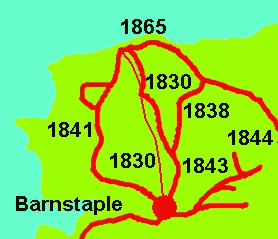 The 1555 Highways Act made each parish responsible for its own roads and local
people were expected to work on the roads for six days each year. This
was unpopular and the roads were neglected, especially in rural Devon. Wheeled
traffic was consequently both difficult and rare. There were few new roads built
and the road network changed very little between the Iron Age
and the mid 18th century (1).
The 1555 Highways Act made each parish responsible for its own roads and local
people were expected to work on the roads for six days each year. This
was unpopular and the roads were neglected, especially in rural Devon. Wheeled
traffic was consequently both difficult and rare. There were few new roads built
and the road network changed very little between the Iron Age
and the mid 18th century (1).
To improve the road network, Turnpike Trusts were permitted to build roads and charge tolls, following an Act of Parliament in 1706. By 1750 there were hundreds of Trusts throughout the Country, but the first Trust in Devon was not until 1751; and that was only for four miles of road. The first Trust in Exeter was in 1753 and the first in Barnstaple was in 1763. The first north of Barnstaple, the Barnstaple to Ilfracombe Trust, was granted in 1830. This was followed by the Combe Martin to Barnstaple Trust in 1838, and the Barnstaple to Braunton Trust in 1841 (above left) (2).
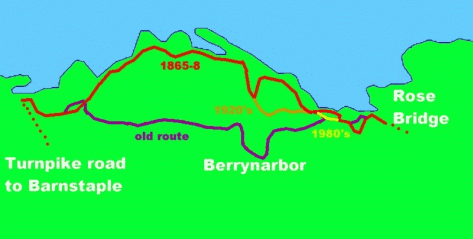
One of the last Turnpike Trusts, the Ilfracombe to Combe Martin Trust, was granted in 1865. The new road was completed in 1868 (below right). This followed, more or less, the route of the current coast road (the A399), but a major inland diversion was built around Napps in the 1920's and there was a further inland diversion around Newberry Close in late 1980's - early 1990's. A small bend near Hele Bay, called Hockey Corner, was straightened out in the 1970's. Before the Trust road, the main road from Ilfracombe came down Hillside Road and then turned sharp right into Hele Village, crossing the bridge and following the back lane to Berrynarbor (3).
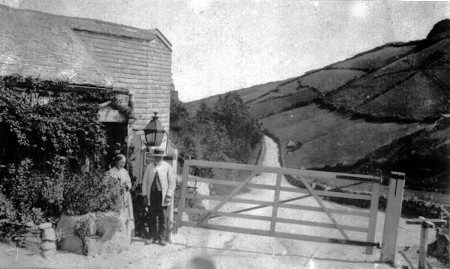
There was a toll-gate at Hele, on the Turnpike road, just to the east of its
junction with Hillside Road. This was a simple farm gate, beside a toll-house,
which appears to have also been a Newsagents (left). The toll-house was
next to a Congregational Chapel; both were demolished when the
main road through Hele was widened in 1913. This picture (below right)
shows the toll-house and chapel in c1905 soon after the Gas Works had opened.
Traffic could avoid the toll-gate by using Hillside Road, but it is very steep.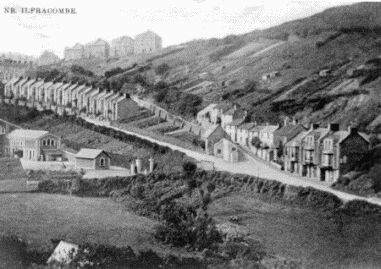
There was another toll-gate at the other end of the Turnpike road in Combe Martin. This was at the junction of Newberry Road and Woodlands. When the turnpike closed it became known as Glenavon Lodge (below left), but it has since been demolished. Traffic could again avoid the toll-gate, by using Newberry Road, but it is very bendy and narrow.
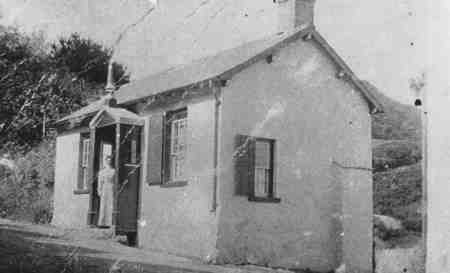 The Trusts began to lose money following the development of the railway and
on July 21st 1888, after only 20 years, the toll gate in Hele was removed, the last toll-gate to be removed in north Devon.
According to the Ilfracombe Chronicle this was "much to the delight of
inhabitants of that village and the country district lying east of Ilfracombe.
The other gates in the neighbourhood were all removed some 3 years ago. All the
traffic to Combe Martin & Lynton had to pass through this gate - the saving to
four-in-hand coaches alone will be over £1 each". The Council became
responsible for the former Turnpike roads in 1889 (4).
The Trusts began to lose money following the development of the railway and
on July 21st 1888, after only 20 years, the toll gate in Hele was removed, the last toll-gate to be removed in north Devon.
According to the Ilfracombe Chronicle this was "much to the delight of
inhabitants of that village and the country district lying east of Ilfracombe.
The other gates in the neighbourhood were all removed some 3 years ago. All the
traffic to Combe Martin & Lynton had to pass through this gate - the saving to
four-in-hand coaches alone will be over £1 each". The Council became
responsible for the former Turnpike roads in 1889 (4).
(1) Before the turnpikes
"The 1555 Highway Act made each parish responsible for its own road network and obliged people to work on them 6 days each year. On the whole this work was unpopular and the roads neglected, for this reason wheeled traffic was scarce. Travellers went on horseback, carriage, or on foot with goods on pack animals. Long strings of pack horses carrying wool, stone, cloth, pottery and even coal were a common sight as late as 1750. Locally it is recorded that packhorses and donkeys were still in general use for travel between Barnstaple and Ilfracombe until the 1830’s." (Thomas 1995 p 173)
Risdon’s description of travelling in Devon c1630 "Rough and unpleasant to strangers travelling those ways, which are cumbersome and uneven, amongst rocks and stones, painful for man and horse" (Hoskins 1954 p 149)
Celia Fiennes, in her 1698 ‘Through England on a side saddle’ wrote that in passing through rural Devon she saw not one pair of wheels, and packhorses and sleds were used for goods (Reed 1997 p 182)
(2) Turnpike trusts
"The first turnpike trust was in 1706 in Buckinghamshire and by 1750 there were 400 trusts throughout the country...Devon was slow to adopt the turnpike system...and Devon never really caught up with the other counties...apart from Stonehouse trust, which was formed in 1751 and had only 4 miles of road, the first trust in Devon was the Exeter Turnpike Trust. This was formed in 1753 ‘for amending several roads leading from the city of Exeter’. All the main roads leading out of Exeter were included as turnpikes with, at 150 miles, the highest mileage of roads maintained by any trust in Devon and one of the highest in the country....The Barnstaple trust was the next largest in Devon and was formed in 1763 with 104 miles of road. It built the A377 along the Taw valley to meet the Exeter turnpike at Eggesford bridge, the A39 between Barnstaple and Bideford and lengths of the present A361, B3226, B3217, B3230 and B3231.....The mile as a measure of distance was introduced to Britain by the Romans, the name derived from ‘milia passuum’, a thousand paces, that worked out at 1680 yds. The statute mile of 1760 yds was introduced by Act of Parliament in 1593 but was not really established until the Act for the establishment of uniform weights and measure of 1824. The later turnpike acts required the trustees to measure their roads and to erect stones or wooden posts giving mileage to towns at 1 mile intervals...with the advent of the railways, revenue from the turnpikes fell off rapidly and by 1890 turnpike trusts had all ceased to exist." (Hawkins 1988 p 19 & 22)
"In the early part of C18th the turnpike trusts were being set up after the Act of Parliament in 1706. Devon was slow to adopt the turnpike system thus remaining in the pack-horse age longer than some areas" (Thomas 1995 p 173)
The Devon Turnpike Trust roads, of which a detail is shown above (from Kanefsky, John 1999 Turnpike Roads in Kain & Ravenhill (eds) 1999 p360)
The first Turnpike Trust for Combe Martin, deposited 13th Nov. 1837, granted 9 May 1838 regarding new roads and sections, 17 miles 6 furlongs total length, south of the Star Inn and by the Church. (Beaumont 1989 p 105).
The Braunton Turnpike Trust was formed in 1841 for the Braunton to Ilfracombe road (Reed 1997 p 182)
(3) The Ilfracombe - Combe Martin Trust
"The pedestrian may cut off the longest bend of the ascent by taking an old lane between it and the sea - a lane that was once the highway, but which no horse that values its knees would care to descend nowadays. At the point where this lane rejoins the road and right overhead rises a steep knoll covered, except about the crown, with oak sapling and underwood [Newberry Hill]." (Page 1895 p 69)
"The Turnpike Act......laid down that the use of a road could be barred to everyone by a gate of pikes stuck into the ground, until a toll was paid. It was a number of years before toll gates came to Ilfracombe but when they did they were erected at Two Potts, Mullacott and Hele. They thus barred the entrance to the district. They were also put up at Portland Street, Church Street and St Brannocks. They thus barred the entrance to the town from which it would appear that some people would have to pay twice. The tolls collected were used to improve existing roads, keeping them in good repair and for building new ones. Before the coming of toll gates, the roads were often in a bad condition, travelling was very uncomfortable as coaches were not very well sprung, and the wheels, being of iron, cut into wet road surfaces, making deep ruts and holes." (Wilson 1976 p 54-5)
In 1865 the second Combe Martin Trust, the ‘Combmartin and Ilfracombe Turnpike Trust’ was passed being the last Turnpike Trust in Devon. The purpose was ‘to make a new road commencing at Rosebridge Combmartin, to a junction with the present Turnpike road from Barnstaple to Ilfracombe, near the east end of Hillsborough Terrace, Ilfracombe....to be purchased by compulsion and agreement lands, houses, hereditaments etc....to buy and collect tolls, rates and duties....the plans to be deposited with the Clerk of the Peace at Exeter castle before 30th November 1865 and with the parish clerk for each parish through which the road will pass.’ The length of the road was stated as 4.5 miles. There had been a proposal in the same year from the Barnstaple Turnpike Trust to build a new road from Combmartin to Ilfracombe via Berrynarbor, but a committee of the House of Commons decided that this should be postponed on account if the large debts of the trust. This originally went round back of Sandaways, until a new road was cut in the 1920’s following cliff falls. None of the local milestones appear to have survived today. (Beaumont 1989 pp 107-111)
The Ilfracombe to Combe Martin Trust built a new coast road between Hele and Combe Martin. This is the present main road, apart from a section around Newberry Hill abandoned after a cliff fall in the 1920’s (Beaumont 1989 p 105)
"The first sod of the Turnpike road was cut on the 15th November 1866, and the road was completed and opened in March 1868. Previously the only road to Ilfracombe was through Berrynarbor village, up Haggington Hill and down to Hele - there was no road in front of Watermouth Castle. When the County took over the roads in the 1880’s no more tolls were collected, and the Toll House became known as Glenavon Lodge." (CMLHG 1997 p 5) See ndj 26th march 1868
The new turnpike road was opened between Combe Martin and Ilfracombe in 1868 and a celebration dinner was held to mark the occasion (IMN 2000 p 10)
There was a tollgate at Hele, marked on the 1889 OS map. A copy of a photograph of the toll-gate in Ilfracombe Museum, shown above (Hele box, ILFCM 2280) is not dated but must be before 1888 when the gate was removed. The toll-house appears to be a newsagents.
The tollgate, old Methodists chapel and new Gas Works are shown above (Hele box, ILFCM 26270B) This has "Hele Toll gate 1905" written on it.
A picture of the Combe Martin toll-house, shown above, has the caption "The Toll House for the Combmartin to Ilfracombe Turnpike road at the Junction of Woodlands and Newberry Road, with Mary Jane Rook, the last occupier, standing in the doorway" (CMLHG 1997 p 5, used by permission of Combe Martin Museum)
1920 - "A new road, 1,100 yards in length between Ilfracombe and Combe Martin has replaced that section destroyed in a serious landslide in 1918" (IMN 2000 p 15)
(4) End of Turnpike Trusts
On July 21st 1888 the last toll gate in North Devon was removed from Hele "The last toll gate in North Devon was removed from Hele, much to the delight of inhabitants of that village and the country district lying east of Ilfracombe. The other gates in the neighbourhood were all removed some 3 years ago. All the traffic to Combe Martin & Lynton had to pass through this gate - the saving to four-in-hand coaches alone will be over £1 each" (IC July 21st 1888 p 5 col 3)
The turnpike trusts were dissolved after the Highways amendment act of 1864, nearly all had gone by 1890. The Highway boards improved the roads and by 1880 they were said to be in excellent condition (Hoskins 1954 p 152)
Turnpikes trusts began in Devon soon after 1750. The London road to Exeter was turnpiked in 1753. Reached a zenith early in the C19th but superseded by the railways and nearly all the Trusts had been wound up by the time the new Council took over the roads in 1889 (Sellman 1962 p 40)